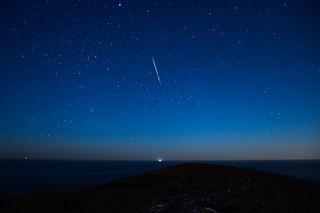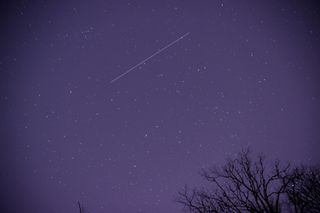See stunning pictures of the Geminid meteor shower of 2021
The meteor shower was at its peak Monday (Dec. 13), but you can still catch a good sky show for a few days.

Social media and photo sites were full of "shooting star" watchers overnight.
The Geminid meteor shower reached its peak Monday (Dec. 13), sparking amateurs and professionals alike to catch a few images of the show. At its peak, there can be as many as 100 to 150 meteors an hour.
This year, skywatchers had a bright waxing moon to contend with, moving to a full phase on Saturday (Dec. 18), but it looks like at least a few bright meteors managed to outshine it. There may still be some bright meteors later in the week, too, so if you were clouded out or busy you may have a chance to see a few Geminids.
Related: How meteor showers work (infographic)


On the professional photography side, Xue Bing in China caught a bright meteor streaking towards the horizon in Bazhou, Xinjiang province, while in Russia, Yuri Smityuk spotted a streaker over Vladivostok, near the Sea of Japan.

A little closer to home, Tayfun Coskun caught a meteor streaking across the sky in Nashville, framed by bare trees on the horizon. And photographers across the world shared their experiences on Twitter, as you can see by a sampling of tweets below.
What a morning. Never in a million years did I think that I'd be able to shoot the Geminid meteor shower in #Pittsburgh, much less directly over the city. But that's exactly what happened today, with this meteor streaking down in just the perfect spot. So many more to come. pic.twitter.com/xlAKvjFpXdDecember 14, 2021
One of the more spectacular examples came from Dave DiCello, who caught a meteor appearing to careen towards the city of Pittsburgh (although rest assured, the meteor was too small to make it to the ground, and too high up to pose any threat.)
Get the Space.com Newsletter
Breaking space news, the latest updates on rocket launches, skywatching events and more!
And despite the bright conditions, some people reported seeing fireballs, and at least one photographer caught the characteristic green flash of a bright meteor.
Huge meteor early this morning during the peak of the Geminid Meteor Shower. This meteor left behind a train! A train is a persistent glow left by a meteor after the meteor trail has faded out. 4:22 am. 12/14/021. 12 pics. 20 sec. exposures. 75mm. 4 minutes. Delton, Michigan pic.twitter.com/OWnGFgcKbmDecember 14, 2021
Saw quiet a few last night, this one probably my favorite. #Geminids #GeminidMeteorShower #CTNatureFans pic.twitter.com/cPamMsSmS6December 14, 2021
Streaking meteor up close. Love that green ionization trail. Good luck tonight to everyone who is looking pic.twitter.com/nXa0aQPFVzDecember 13, 2021
Some shots from the Geminid meteor shower. I did see a "fireball" sometime between 12 and 1 a.m. but of course my camera was pointed in a different direction when that one happened 😑😆✨ #GeminidMeteorShower #WV @StormHour @SpencerWeather pic.twitter.com/Hfz2mMKQ6mDecember 14, 2021
If you're hoping to capture photos of the Geminid meteors, our guide on how to photograph meteor showers can help. You can also use our best cameras for astrophotography and best lenses for astrophotography guides to prepare for the next meteor shower.
Editor's note: If you snap an amazing photo of a Geminid meteor or any other night-sky sight and you'd like to share it with Space.com for a story or image gallery, send images, comments and location information to spacephotos@space.com.
Follow Elizabeth Howell on Twitter @howellspace. Follow us on Twitter @Spacedotcom or on Facebook.
Join our Space Forums to keep talking space on the latest missions, night sky and more! And if you have a news tip, correction or comment, let us know at: community@space.com.

Elizabeth Howell (she/her), Ph.D., is a staff writer in the spaceflight channel since 2022 covering diversity, education and gaming as well. She was contributing writer for Space.com for 10 years before joining full-time. Elizabeth's reporting includes multiple exclusives with the White House and Office of the Vice-President of the United States, an exclusive conversation with aspiring space tourist (and NSYNC bassist) Lance Bass, speaking several times with the International Space Station, witnessing five human spaceflight launches on two continents, flying parabolic, working inside a spacesuit, and participating in a simulated Mars mission. Her latest book, "Why Am I Taller?", is co-written with astronaut Dave Williams. Elizabeth holds a Ph.D. and M.Sc. in Space Studies from the University of North Dakota, a Bachelor of Journalism from Canada's Carleton University and a Bachelor of History from Canada's Athabasca University. Elizabeth is also a post-secondary instructor in communications and science at several institutions since 2015; her experience includes developing and teaching an astronomy course at Canada's Algonquin College (with Indigenous content as well) to more than 1,000 students since 2020. Elizabeth first got interested in space after watching the movie Apollo 13 in 1996, and still wants to be an astronaut someday. Mastodon: https://qoto.org/@howellspace